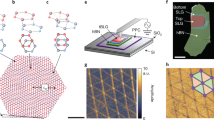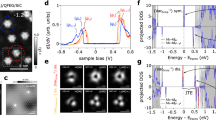Abstract
States with spontaneously broken symmetry can form due to Coulomb interactions in electronic systems with multiple internal degrees of freedom. Materials with several degenerate regions in the Brillouin zone—called valleys—offer a rich setting for the emergence of such states, which have potential electronic and optical applications1,2,3,4. To date, identification of these broken-symmetry phases has mostly relied on macroscopic transport or optical properties. Here we demonstrate a direct approach by visualizing the wavefunctions of bismuth surface states with a scanning tunnelling microscope. Strong spin–orbit coupling on the surface of bismuth leads to six degenerate, teardrop-shaped, hole valleys5. Our spectroscopic measurements reveal that exchange interactions fully lift this degeneracy at high magnetic field, and we are able to determine the nature of the valley ordering by imaging the broken-symmetry Landau level wavefunctions. The spatial features of singly degenerate Landau level wavefunctions near isolated defects contain unique signatures of interference between spin-textured valleys, which identify the electronic ground state as a quantum Hall ferroelectric. Our observations confirm the recent prediction6 that interactions in strongly anisotropic valley systems favour the occupation of a single valley, giving rise to emergent ferroelectricity in the surface state of bismuth.
This is a preview of subscription content, access via your institution
Access options
Access Nature and 54 other Nature Portfolio journals
Get Nature+, our best-value online-access subscription
$29.99 / 30 days
cancel any time
Subscribe to this journal
Receive 12 print issues and online access
$209.00 per year
only $17.42 per issue
Buy this article
- Purchase on Springer Link
- Instant access to full article PDF
Prices may be subject to local taxes which are calculated during checkout




Similar content being viewed by others
References
Yafis, B., Kun, Y. & MacDonald, A. H. Quantum Hall effects in graphene-based two-dimensional electron systems. Nanotechnology 23, 052001 (2012).
Xu, X., Yao, W., Xiao, D. & Heinz, T. F. Spin and pseudospins in layered transition metal dichalcogenides. Nat. Phys. 10, 343–350 (2014).
Schaibley, J. R. et al. Valleytronics in 2D materials. Nat. Rev. Mater. 2, 16087 (2016).
Shayegan, M. et al. Two-dimensional electrons occupying multiple valleys in AlAs. Phys. Status Solidi B 243, 3629–3642 (2006).
Ast, C. R. & Höchst, H. Fermi Surface of Bi(111) measured by photoemission spectroscopy. Phys. Rev. Lett. 87, 177602 (2001).
Sodemann, I., Zhu, Z. & Fu, L. Quantum Hall ferroelectrics and nematics in multivalley systems. Phys. Rev. X 7, 041068 (2017).
Girvin, S. M. The Quantum Hall Effect: Novel Excitations and Broken Symmetries 116–119 (Springer, Berlin,1999).
Young, A. F. et al. Spin and valley quantum Hall ferromagnetism in graphene. Nat. Phys. 8, 550–556 (2012).
Shkolnikov, Y. P., Misra, S., Bishop, N. C., De Poortere, E. P. & Shayegan, M. Observation of Quantum Hall “valley skyrmions”. Phys. Rev. Lett. 95, 066809 (2005).
Kott, T. M., Hu, B., Brown, S. H. & Kane, B. E. Valley-degenerate two-dimensional electrons in the lowest Landau level. Phys. Rev. B 89, 041107 (2014).
Young, A. F. et al. Tunable symmetry breaking and helical edge transport in a graphene quantum spin Hall state. Nature 505, 528–532 (2014).
Maher, P. et al. Evidence for a spin phase transition at charge neutrality in bilayer graphene. Nat. Phys. 9, 154–158 (2013).
Abanin, D. A., Parameswaran, S. A., Kivelson, S. A. & Sondhi, S. L. Nematic valley ordering in quantum Hall systems. Phys. Rev. B 82, 035428 (2010).
Zhu, Z., Collaudin, A., Fauqué, B., Kang, W. & Behnia, K. Field-induced polarization of Dirac valleys in bismuth. Nat. Phys. 8, 89–94 (2011).
Feldman, B. E. et al. Observation of a nematic quantum Hall liquid on the surface of bismuth. Science 354, 316–321 (2016).
Dziawa, P. et al. Topological crystalline insulator states in Pb1−xSnxSe. Nat. Mater. 11, 1023–1027 (2012).
Dawber, M., Rabe, K. M. & Scott, J. F. Physics of thin-film ferroelectric oxides. Rev. Mod. Phys. 77, 1083–1130 (2005).
Martin, L. W. & Rappe, A. M. Thin-film ferroelectric materials and their applications. Nat. Rev. Mater. 2, 16087 (2016).
Chang, K. et al. Discovery of robust in-plane ferroelectricity in atomic-thick SnTe. Science 353, 274–278 (2016).
Koroteev, Y. M. et al. Strong spin–orbit splitting on Bi surfaces. Phys. Rev. Lett. 93, 046403 (2004).
Hirahara, T. et al. Role of spin–orbit coupling and hybridization effects in the electronic structure of ultrathin Bi films. Phys. Rev. Lett. 97, 146803 (2006).
Ohtsubo, Y. et al. Giant anisotropy of spin–orbit splitting at the bismuth surface. Phys. Rev. Lett. 109, 226404 (2012).
Du, H. et al. Surface Landau levels and spin states in bismuth (111) ultrathin films. Nat. Commun. 7, 10814 (2016).
Takayama, A., Sato, T., Souma, S. & Takahashi, T. Giant out-of-plane spin component and the asymmetry of spin polarization in surface Rashba states of bismuth thin film. Phys. Rev. Lett. 106, 166401 (2011).
Saito, K., Sawahata, H., Komine, T. & Aono, T. Tight-binding theory of surface spin states on bismuth thin films. Phys. Rev. B 93, 041301 (2016).
Kotaka, H., Ishii, F. & Saito, M. First-principles study of spin texture and Fermi lines in Bi(111) multi-layer nanofilm. Preprint at https://arxiv.org/abs/1703.08287 (2017).
Kumar, A., Parameswaran, S. A. & Sondhi, S. L. Order by disorder and by doping in quantum Hall valley ferromagnets. Phys. Rev. B 93, 014442 (2016).
Misra, S. et al. Design and performance of an ultra-high vacuum scanning tunneling microscope operating at dilution refrigerator temperatures and high magnetic fields. Rev. Sci. Inst. 84, 103903 (2013).
Crommie, M. F., Lutz, C. P. & Eigler, D. M. Imaging standing waves in a two-dimensional electron gas. Nature 363, 524–527 (1993).
Hsieh, T. H. et al. Topological crystalline insulators in the SnTe material class. Nat. Commun. 3, 982 (2012).
Lian, Y. & Goerbig, M. O. Spin-valley skyrmions in graphene at filling factor ν = 1. Phys. Rev. B 95, 245428 (2017).
Papić, Z., Mong, R. S. K., Yazdani, A. & Zaletel, M. P. Imaging anyons with scanning tunneling microscopy. Phys. Rev. X 8, 011037 (2018).
Acknowledgements
We would like to thank I. Sodemann and L. Fu for helpful discussions. Work at Princeton has been supported by the Gordon and Betty Moore Foundation as part of the EPiQS initiative (GBMF4530), DOE-BES grant DE-FG02-07ER46419, the ARO-MURI program W911NF-12-1-046, NSF-MRSEC programs through the Princeton Center for Complex Materials DMR-142054 and NSF-DMR-1608848, the Eric and Wendy Schmidt Transformative Technology Fund at Princeton, an NSF Graduate Research Fellowship (M.T.R.) and a Dicke fellowship (B.E.F.). Work at Austin was supported by DOE grant DE-FG03-02ER45958 and by the Welch Foundation grant TBF1473. The work of F.W. at Argonne is supported by the Department of Energy, Office of Basic Energy Science, Materials Science and Engineering Division.
Author information
Authors and Affiliations
Contributions
M.T.R., B.E.F., H.D., A.G. and A.Y. designed and conducted the STM measurements and their analysis. F.W. and A.H.M. performed the theoretical modelling and simulations. H.J. and R.J.C. synthesized the samples. All authors contributed to the writing of the manuscript.
Corresponding author
Ethics declarations
Competing interests
The authors declare no competing interests.
Additional information
Publisher’s note: Springer Nature remains neutral with regard to jurisdictional claims in published maps and institutional affiliations.
Supplementary information
Supplementary Information
Supplementary figures 1–10, theoretical details and numerical simulations
Rights and permissions
About this article
Cite this article
Randeria, M.T., Feldman, B.E., Wu, F. et al. Ferroelectric quantum Hall phase revealed by visualizing Landau level wavefunction interference. Nature Phys 14, 796–800 (2018). https://doi.org/10.1038/s41567-018-0148-2
Received:
Accepted:
Published:
Issue Date:
DOI: https://doi.org/10.1038/s41567-018-0148-2
This article is cited by
-
Evidence of two-dimensional flat band at the surface of antiferromagnetic kagome metal FeSn
Nature Communications (2021)
-
Valley interference and spin exchange at the atomic scale in silicon
Nature Communications (2020)
-
Interacting multi-channel topological boundary modes in a quantum Hall valley system
Nature (2019)



